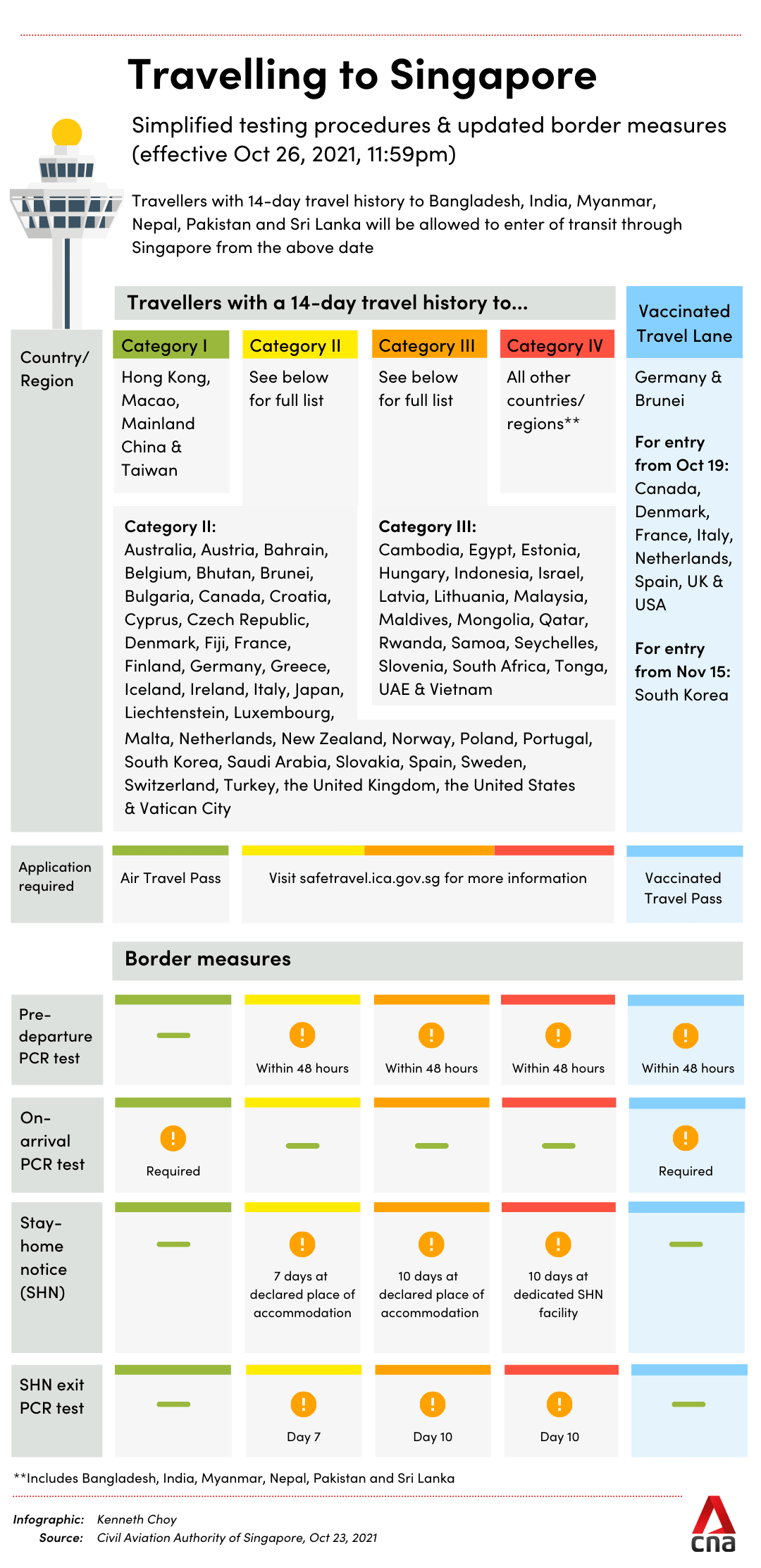Singapore to allow some travellers from South Asia, ease stay-home notice restrictions for Malaysia and Indonesia
SINGAPORE: Singapore announced on Saturday (Oct 23) that it will reopen its borders to some travellers from six countries, including Bangladesh and India, as well as loosen testing and stay-home notice restrictions for several other countries, including Malaysia and Indonesia.
This follows a review of the COVID-19 situation in these countries, said the Ministry of Health (MOH) in a media release.
From 11.59pm on Oct 26, travellers (excluding short-term visitors) with a 14-day travel history to Bangladesh, India, Myanmar, Nepal, Pakistan and Sri Lanka, prior to departure to Singapore will be allowed to enter or transit through the country again.
These travellers will be subject to Category IV border restrictions, which include a 10-day stay-home notice at dedicated facilities.
STAY-HOME NOTICE PROTOCOLS SIMPLIFIED
On top of that, Malaysia, Cambodia, Egypt, Hungary, Indonesia, Israel, Mongolia, Qatar, Rwanda, Samoa, Seychelles, South Africa, Tonga, the United Arab Emirates (UAE) and Vietnam, will be placed under Category III measures.
From 11.59pm on Oct 26, all travellers from Category III regions will be able to serve their 10-day stay-home notice at their declared place of residence or accommodation – regardless of the vaccination status and travel history of the traveller and their household members.
Category III travellers currently have to apply to opt out of serving their stay-home notice at dedicated facilities, subject to certain restrictions.
“By default, they will not be allocated accommodation in any dedicated SHN facilities,” said MOH on Saturday.
Returning residents should ensure they can secure alternative accommodation prior to their return if their homes are unsuitable for their stay-home notice, it added.
But the authority added that these travellers must remain in their declared place of residence or accommodation throughout their stay-home notice period, and wear an electronic monitoring device.
“Action will be taken against those who breach their SHN requirements or make false declaration,” said MOH.
FEWER TESTS FOR TRAVELLERS
In addition, most travellers will undergo fewer tests from 11.59pm on Oct 26.
All travellers from Category II (non-Vaccinated Travel Lane destinations), III and IV countries will no longer need to undergo an on-arrival Polymerase Chain Reaction (PCR) test.
Instead, they will only undergo an exit PCR test at the end of their stay-home notice.
Category III and IV travellers will also no longer have to undergo additional Antigen Rapid Test (ARTs) on the third and seventh days of their arrival, during their stay-home notice period.
FULLY-VACCINATED DOMESTIC WORKERS
Authorities had also previously announced that the country will allow necessary workers and students to enter Singapore in a “safe and calibrated manner” from Nov 1, as long as they are fully vaccinated before arrival.
“As part of this move, we will facilitate the entry of more domestic workers, to meet urgent domestic and caregiving needs of local households, while regulating the numbers carefully as the global situation evolves,” said the release.
WHY IS SINGAPORE RELAXING ITS BORDERS?
Speaking at a press conference by the COVID-19 task force, Health Minister Ong Ye Kung said one of the most common questions asked was why Singapore was re-opening its borders, despite not easing domestic restrictions such as allowing larger groups to dine in.
He explained that border restrictions were earlier put in place to prevent infections from “gushing into” the country.
“Now the situation has changed,” he said.
“After going through big transmission waves for many months, the pandemic situations in many countries have stabilised and their infection rates are - some of them are even lower than Singapore's. So we can open up travel lanes with these countries safely.”
To be even safer, only fully vaccinated travellers are allowed, and testing is required – which is why imported infections only constitute “a very small fraction” of total community infections, he said.
There are also many benefits to opening the borders, including allowing the country to bring in “much needed” workers to complete infrastructure projects, such as public housing flats, he said.
Allowing in domestic workers will also relieve the stress on many families in Singapore, he said.
“I think (these steps) will make life easier for many businesses, for contractors, as well as for families.”
A reporter also asked Mr Ong whether other countries’ categorisation of Singapore as a “high-risk” destination would impact travel negotiations with nations such as Australia.
To that, Mr Ong said: “I think they are reflecting the fact that we are going through a big wave … But there's a lot of goodwill between these partners, not just Germany and US, but also Australia.”
“At some point (infections) will stabilise, (they) will come down. And we all want to work together, maintain our connections, our people-to-people exchanges.
“And so, it should not, and I don't think it will stop us from continuing our joint initiative to develop vaccinated travel lanes,” said Mr Ong.
Editor’s note: This story has been updated to reflect a revised press release from the Ministry of Health, which subsequently excluded short-term visitors from Bangladesh, India, Myanmar, Nepal, Pakistan and Sri Lanka from being able to enter or transit through Singapore, under newly announced border measures.

Watch the full news conference by the multi-ministry task force and subsequent Q&A session with journalists:
BOOKMARK THIS: Our comprehensive coverage of the COVID-19 pandemic and its developments
Download our app or subscribe to our Telegram channel for the latest updates on the coronavirus pandemic: https://cna.asia/telegram

















